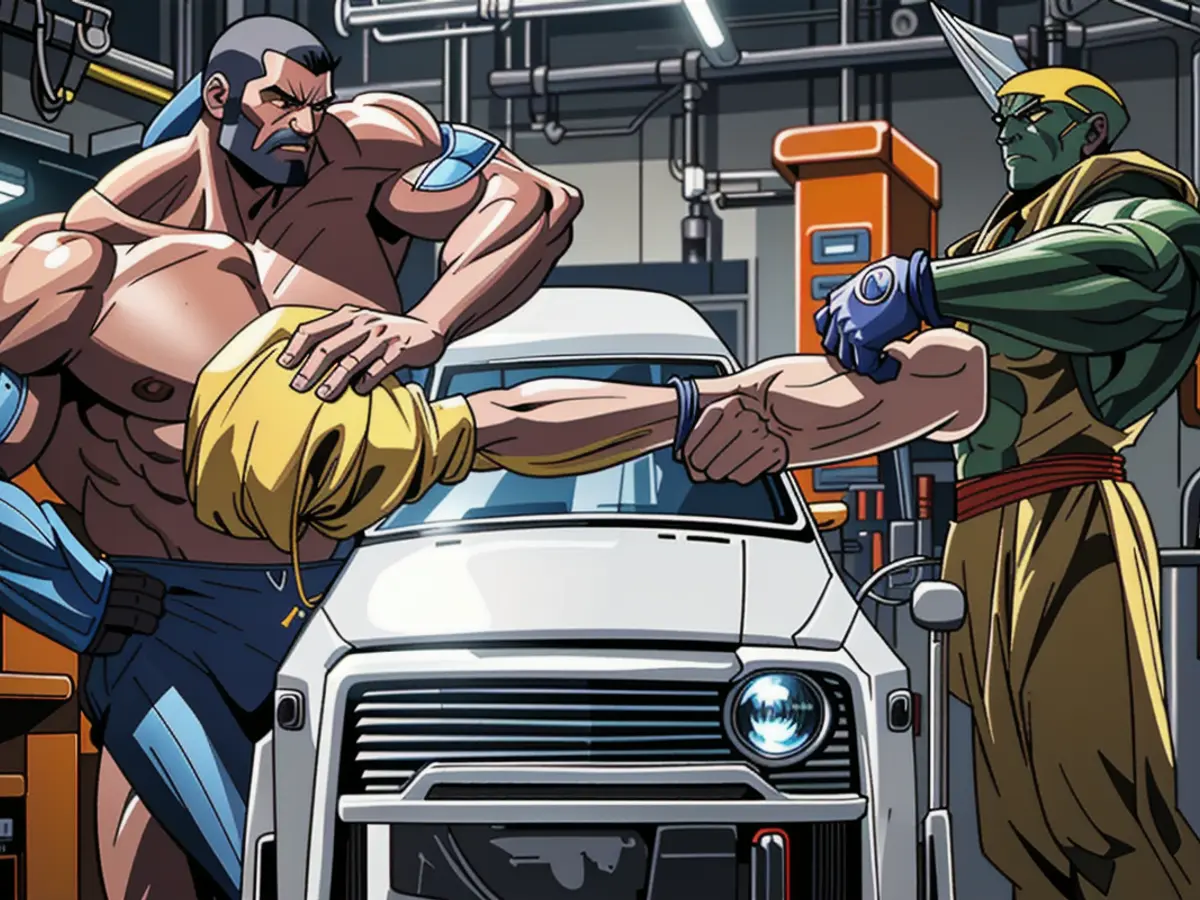U.S. Automotive Sector Faces Competitive Threat, Warns Straightforward Report from Industry Leaders
Challenges such as threats from China, sluggish vehicle sales, slower-than-expected electric vehicle adoption, inadequate lobbying, wasteful product development practices, and harsh regulatory pressures are all contributing to a perilous situation for the U.S. automotive industry.
This is the crux of an unreserved and enlightening "white paper" constructed by senior figures in the auto industry during October's 2024 SAE Detroit Section Global Leadership Conference (GLC), which is now being circulated among insiders as they share the comprehensive seven-page document.
The GLC is an annual, exclusive, meetup held at The Greenbrier resort in White Sulphur Springs, West Virginia, accommodating prominent industry executives who discuss "thought-provoking and challenging" topics, as stated by top organizer Renee’ Bovair, executive director of SAE Detroit Section, in an interview.
"In essence, the U.S. automotive sector is in peril," the paper declares. "Our manufacturing capacity and labor force are dwindling, and, on its present trajectory, the automotive industry will conclude the decade as a considerably smaller and weaker economic force compared to its current status."
Indeed, the paper also highlights how these obstacles are not merely jeopardizing the U.S. auto industry, but the industry as a whole is at a "tipping point."
"Our primary objective wasn't just to present a checklist of all the problems, all the chaos, but rather, how can we translate this into a set of recommendations, or at least a basic path forward that the industry can employ to tackle some of these monumental challenges," said JP Flaharty, executive program manager at Toyota Motor North America Research & Development, who served as this year’s GLC chairperson.
Jeopardy from electric vehicle mandates
Some of the principal challenges include stern federal fuel efficiency standards, set to go into effect in 2027, driving the production and marketing of battery electric vehicles.
"So far, the public is not purchasing these vehicles in the numbers needed to meet these standards. In fact, a substantial portion of the public has no interest in them," the paper suggests. "The industry is losing billions annually on EVs, without any sign of relief."
"Asking automakers to make this transition this quickly and then not having products selling is a significant drain on capital," added Jeff Walker, conference co-chair and chief commercial officer at online automotive software marketplace SDVerse, in an interview.

Swiftly shifting technology
The simultaneous push towards more software-driven vehicles and electrified cars and trucks presents significant financial, cultural, and intellectual challenges for the industry, the paper reveals, noting that "all these transitions are happening simultaneously, and while the industry will eventually master these breakthrough technologies, it is taking an enormous effort, accompanied by numerous delays, and at enormous expense."
Walker's company, SDVerse, launched in September, operates as an online software marketplace that connects automakers and software developers to buy and sell software. It aims to simplify and speed up SDV development at lower cost, explained Walker. It also illustrates collaboration on pre-competitive aspects of product development, which competing companies can share while retaining proprietary properties.
A stagnant market
The term "peak auto," which may seem optimistic, actually refers to a situation where vehicle sales have plateaued in North America, Europe, Japan, and South Korea, with fewer vehicles sold in these countries than a decade ago.
The paper remarks, "This is a perfect storm of disruptive changes hitting the industry at the same time: regulations demanding investments that will not produce a financial return; the necessity of adopting new technology that is difficult and costly to master; intense Chinese pressure that is only growing more potent; and a stagnant market offering little opportunity for growth."
Challenges from Chinese expansion
Threats from China come from various fronts. By securing the supply chain for producing electric vehicles, Chinese manufacturers enjoy a 35% production cost advantage, according to the paper.
Furthermore, China's manufacturing overcapacity has led to aggressive exporting, with the paper forecasting that by the end of the decade, China will export as many vehicles as the U.S. builds annually.

As the paper reveals, "Over the last five years, the Detroit Three automakers lost 6.6% points of global market share to Chinese automakers and EV startups. That represents approximately 5.6 million units of capacity and tens of thousands of jobs."
Dropping outdated engineering priorities
A key observation and recommendation is that the global auto industry cannot compete with China unless it discards some outdated practices.
As an example, the paper points to structural beams inside the instrument panels on EVs built by some legacy automakers using specifications that were needed to eliminate vibrations from piston engines.
"Yet even though electric cars do not produce these kinds of vibrations, the structural beams are still built to these specifications, and that adds unnecessary cost and weight," the paper comments.
It is essential that these legacy automakers study what younger U.S. manufacturers, such as Tesla and Rivian, who are not burdened by these heritage practices, are doing, as well as how the Chinese operate, Flaharty concluded.
"Basically, what we're talking about is recognizing there may be, perhaps, more risk in following some of these approaches that we see, particularly from the leading Chinese automakers. However, if we don't pay attention to what they're doing and start to shift in their direction, we'll be left behind."
Another important lesson from China's auto industry, according to the report, is its ability to swiftly bring products to market without being overly concerned about perfect designs from the start. They simply aim to make it functional. Then, they can assess and improve upon it later.
Lacking Political Clout

In spite of the automotive industry's considerable size and global reach, its political influence in Washington D.C. is remarkably weak.
"When it comes to lobbying in Washington D.C., the automotive industry falls short of its potential," the report stated. "Only three out of the sixteen or so automotive manufacturers operating in the U.S. have their own Political Action Committees."
The report also highlighted the challenge of manufacturers and suppliers having diverse requirements and goals. Additionally, domestic companies may have different perspectives than their domestic counterparts.
"It's not about picking sides or aligning with a specific party, but rather engaging with the entire spectrum of government officials, building relationships, and ensuring they fully comprehend the complexity of the challenge," said Flaharty.
The report was prepared prior to the elections, during which Donald Trump was re-elected as President. Trump has suggested imposing high tariffs on imported goods, including vehicles and components, particularly those made in China. Flaharty mentioned that this proposal sparked some debate at the conference about the potential advantages and disadvantages of such a policy shift.
Response and Conclusions
"The industry has been remarkably supportive of the fact that we've released this report," said Walker, who will chair the GLC next year. "I've received no fewer than four emails from executives or consultants stating things like 'about time' and 'it's about time we did this.'
The report concluded, "Fresh approaches and intelligent policy can provide a boost to the industry and boost its economic impact. This report serves as a Call to Action to initiate the development of such a strategy."
The auto industry leaders at the SAE Detroit Section Global Leadership Conference acknowledged that China's expansion into electric vehicles and its production cost advantage pose significant threats to the U.S. automotive industry. Furthermore, the lack of political clout in Washington D.C. and the industry's slow response to electric vehicle mandates are compounding these challenges.
Moreover, the rapid shift towards software-driven vehicles and electrification presents financial, cultural, and intellectual challenges, which are taking an enormous effort and expense to master. The report emphasizes the need for the industry to study successful practices from Chinese manufacturers and newer U.S. companies to remain competitive.






